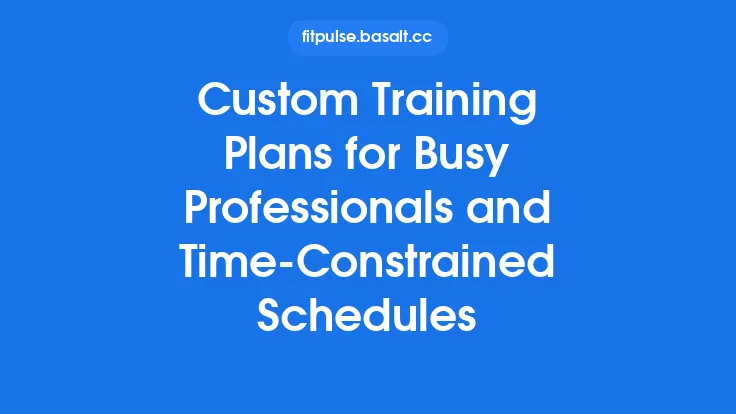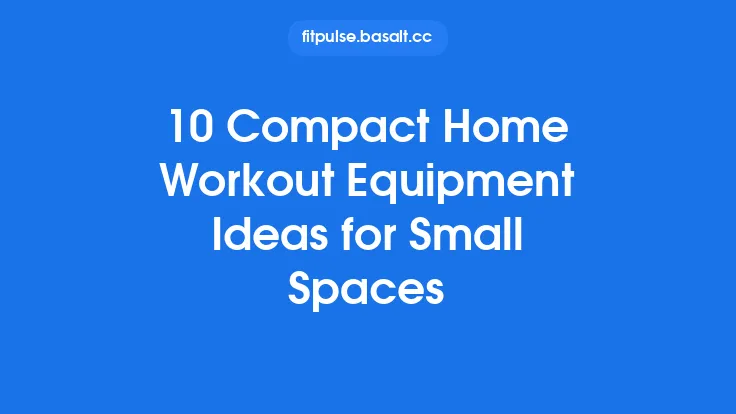Portable strength training has come a long way. Whether you live in a studio apartment, share a room with a roommate, or simply need gear that can fit in a suitcase for a weekend getaway, there are plenty of high‑quality options that let you keep building muscle without sacrificing space or convenience. Below is a comprehensive guide to the most effective, space‑saving equipment, how each piece works, what to look for when buying, and ideas for integrating them into a full‑body routine.
Resistance Bands and Tubes
Why they’re a staple
Resistance bands are arguably the most versatile portable strength tool. Made from latex, rubber, or thermoplastic elastomer (TPE), they provide progressive tension that can be adjusted simply by changing the band’s length or thickness. Because they store energy elastically, they’re ideal for both concentric (pull) and eccentric (release) phases of a lift, which can improve muscle activation and joint stability.
Types and key specs
| Type | Typical Use | Pros | Cons |
|---|---|---|---|
| Loop (mini) bands | Hip abduction, glute activation, warm‑ups | Small, inexpensive, easy to anchor | Limited to lower‑body or light‑resistance work |
| Flat “TheraBand” tubes | Upper‑body pulls, rows, shoulder work | Handles for a comfortable grip, easy to adjust tension | Slightly bulkier than loops |
| Figure‑8 or “V‑band” | Biceps curls, triceps extensions, chest flyes | Handles on both ends, good for bilateral work | Can be harder to find in very high resistance |
| Heavy‑duty “Power” bands | Assisted pull‑ups, squat overload, power‑lifting prep | Very high resistance (up to 200 lb) | Thick and may be harder to store |
When selecting bands, check the tensile strength rating (often listed in pounds or kilograms) and the material durability. Latex offers the best elasticity but can degrade with UV exposure; TPE is odor‑free and more resistant to wear but may feel stiffer.
Space & travel tips
All bands fold or roll into a small pouch (often under 6 × 6 in). For travel, keep a set of three different resistance levels (light, medium, heavy) in a zip‑lock bag to protect them from moisture.
Suspension Training Systems
What they are
Suspension trainers consist of adjustable straps with handles (or foot loops) that anchor to a sturdy point—doorframe, ceiling beam, tree branch, or a purpose‑built mount. By changing your body angle, you can vary the load from near‑bodyweight to a challenging 80 % of your own weight.
Key features to evaluate
- Anchor compatibility – Look for a system that includes a door‑frame attachment, a carabiner for outdoor use, and a wall‑mount bracket if you have a permanent spot.
- Strap material – High‑density nylon with reinforced stitching offers durability; some models add a padded interior for comfort.
- Adjustability range – A 12‑foot strap length covers most exercises, from inverted rows to single‑leg pistol squats.
- Portability – Most kits fold into a compact bag (≈ 8 × 10 in) and weigh under 2 lb.
Why it works for small spaces
Because the trainer hangs from a single point, you can set it up in a doorway, living‑room corner, or even a hotel bathroom (provided the door is sturdy). The entire system can be removed in seconds, leaving no permanent footprint.
Portable Pull‑Up and Chin‑Up Bars
Options
- Door‑frame pull‑up bar – A spring‑loaded or screw‑mounted bar that fits across a standard doorframe (typically 28–32 in wide). It uses leverage rather than screws, so it’s renter‑friendly.
- Wall‑mounted bar – Requires a stud or solid wall anchor; offers a more stable platform for heavy‑weight training.
- Freestanding “power pole” – A telescoping pole that leans against a wall; can be moved and stored upright.
Choosing the right one
- Weight capacity – Ensure the bar can support at least 250 lb if you plan to add weight (e.g., weighted vest).
- Grip options – Look for multiple grip positions (neutral, supinated, pronated) to target different muscle groups.
- Installation ease – For renters, a non‑permanent, pressure‑mounted bar is safest.
Space considerations
A door‑frame bar folds flat when not in use, taking up virtually no space. Freestanding poles can be stored vertically in a closet.
Foldable Dip Bars and Push‑Up Handles
Why they matter
Dips are a superb compound movement for chest, triceps, and anterior deltoids. Portable dip bars let you perform them without a bench or parallel bars.
Designs
- Collapsible “U‑shaped” dip stations – Two arms that lock together and can be folded flat. Height is adjustable (usually 30–45 in).
- Push‑up handle sets – Small, rotating handles that elevate the wrists, reducing strain and increasing range of motion.
Key specs
- Load rating – Minimum 300 lb for dip stations.
- Material – Powder‑coated steel for rust resistance.
- Footprint – When folded, most dip stations occupy a 12 × 12 in box.
Travel tip – Some dip bars come with a carrying case and can be slipped into a large suitcase.
Weighted Vests and Ankle/Wrist Weights
Purpose
Adding external load to bodyweight movements (squats, lunges, push‑ups, pull‑ups) increases muscular demand without needing bulky equipment.
Weighted vests
- Adjustable pockets – Allows you to add or remove small plates or sandbags to reach 5–30 lb (or more for advanced users).
- Fit – Look for a vest with a wide, padded back and secure Velcro or buckle closures to prevent shifting.
- Material – Breathable mesh reduces heat buildup.
Ankle/Wrist weights
- Weight range – Typically 1–5 lb per strap; ideal for adding subtle resistance to leg lifts, hip abductions, or arm extensions.
- Fastening – Velcro straps with a wide base distribute pressure evenly.
Storage – Both vests and weight straps can be folded and stored in a drawer; they add minimal volume.
Sandbags and Adjustable Fillable Bags
What they are
A sandbag is a durable canvas or nylon sack filled with sand, gravel, or even water. Modern versions feature a dual‑compartment design that lets you adjust the weight in 5‑lb increments.
Benefits for small spaces
- Shape adaptability – The bag conforms to your body, challenging stabilizer muscles.
- Compact storage – When empty, the bag folds flat (≈ 12 × 12 in). Even filled, it can be tucked under a bed or stored in a closet.
- Versatility – Use for carries, drags, cleans, presses, and even as a makeshift bench for floor presses.
Choosing a sandbag
- Reinforced seams – Double‑stitched or welded seams prevent leaks.
- Handles – Integrated webbing handles or D‑rings allow multiple grip options.
- Weight range – Starter kits often include 20, 40, and 60 lb bags; you can combine them for heavier loads.
Compact Medicine Balls and Slam Balls
Why they belong
Medicine balls provide a solid, dense load for explosive movements (throws, slams, rotational twists) and can double as a weighted core tool for sit‑ups or Russian twists.
Key considerations
- Material – Rubber or vinyl coating prevents damage to floors and furniture.
- Diameter – A 10‑inch ball (6–10 lb) fits comfortably on a standard living‑room rug; larger 12‑inch balls (12–20 lb) are still manageable.
- Grip – Textured surfaces improve handling during slams.
Space‑saving tip – Store the ball in a corner or under a bed when not in use; its spherical shape makes it easy to tuck away.
Portable Plyometric Boxes and Step Platforms
Function
Plyo boxes enable box jumps, step‑ups, and elevated push‑ups. Portable versions are foldable or collapsible, breaking down into flat panels that stack.
Features to look for
- Adjustable height – Some models have three or four height settings (12, 18, 24, 30 in) via sliding panels.
- Load capacity – Minimum 300 lb; higher is better for added weight.
- Surface – Anti‑slip rubber coating protects floors and provides traction.
Storage – When collapsed, the box can be stored in a closet or under a sofa, occupying roughly the footprint of a large shoebox.
Travel‑Friendly Landmine Attachments
Concept
A landmine setup consists of a pivoting sleeve that fits into a corner or a sturdy base, allowing you to load a single weight (often a sandbag or a compact plate) and perform rotational presses, rows, and twists.
Portable versions
- Corner‑mount landmine – A short metal tube that slides into the corner of a room; no permanent installation required.
- Base‑plate landmine – A weighted base (filled with sand or water) that stabilizes the sleeve; can be moved from room to room.
Why it’s useful
- Provides a single‑point pivot for unilateral and rotational movements, which are hard to replicate with bands alone.
- Takes up minimal floor space (≈ 6 × 6 in) and can be stored in a closet when not in use.
Multi‑Functional Portable Gym Systems
Examples – Bowflex‑style resistance rod kits, Power Rods, or compact “all‑in‑one” home gyms that use a stacked spring or polymer resistance mechanism.
Advantages
- Single‑unit design – One piece of equipment replaces dozens of dumbbells or machines.
- Adjustable resistance – Turn a dial or move a selector to change tension from 5 lb up to 200 lb.
- Compact footprint – Many systems fold into a vertical column (≈ 12 × 12 in) that can be stored upright.
Things to verify
- Resistance curve – Some systems provide a linear increase, while others have a “progressive” curve that feels lighter at the start of the movement.
- Attachment variety – Look for handles, ankle straps, and a barbell‑style grip to expand exercise options.
- Durability – High‑quality polymer or steel rods last longer than cheap plastic mechanisms.
Choosing the Right Portable Equipment for Your Space and Lifestyle
- Assess your primary training goals – If you need upper‑body pulling strength, prioritize a suspension trainer and pull‑up bar. For lower‑body power, sandbags, plyo boxes, and weighted vests are key.
- Measure your available floor area – Even a compact system needs a clear zone for safe movement (typically 4 × 4 ft for most bodyweight exercises).
- Consider travel frequency – If you travel monthly, focus on ultra‑light items (bands, suspension straps, foldable dip bars). If you only need occasional portability, a portable landmine or compact gym system may be worth the extra weight.
- Budget vs. durability – Latex bands are cheap but wear out faster; TPE bands cost more but last longer. Investing in a high‑quality suspension trainer can save money in the long run because it replaces many other accessories.
- Noise level – Sandbags and medicine balls are quieter than metal plates, making them ideal for apartments.
Maintenance and Care Tips for Portable Gear
- Resistance bands – After each use, wipe with a damp cloth and let them air‑dry. Store away from direct sunlight and heat to prevent latex degradation.
- Suspension straps – Check stitching and carabiner locks weekly. Replace any frayed straps immediately.
- Pull‑up bars – Tighten any screws or tension mechanisms before each session. Use a protective pad on the doorframe to avoid scratches.
- Sandbags – Periodically empty and shake out the filler to prevent clumping. If using sand, keep the bag sealed with a zip‑lock or inner liner to avoid leaks.
- Weighted vests – Remove the weight inserts after each workout to air out the vest, reducing odor buildup.
- Foldable boxes – Wipe down the surface after each use, especially if you’ve performed high‑impact jumps that can generate dust.
Regular inspection not only extends the life of your equipment but also ensures safety during intense sessions.
Sample Full‑Body Workout Using Only Portable Gear
Warm‑up (5 min)
- 30 sec banded shoulder dislocations (light loop band)
- 30 sec banded hip openers (medium loop)
- 1 min jumping jacks (no equipment)
Circuit – Perform 3 rounds, 45 sec work / 15 sec rest
- Suspension Trainer Row – Adjust straps to a moderate angle; pull chest to handles.
- Weighted Vest Goblet Squat – Hold a sandbag at chest level; squat deep.
- Band‑Resisted Push‑Up – Loop a band across your upper back, anchor under palms.
- Single‑Leg Romanian Deadlift with Ankle Weights – Balance and hinge, alternating legs.
- Medicine Ball Slam – Explosive overhead slam, catching on the rebound.
Finisher (4 min)
- Pull‑Up Bar Hang – 30 sec hold, 30 sec rest, repeat 4× (use a band for assistance if needed).
Cool‑down (5 min)
- Stretch major muscle groups, using a light band for assisted hamstring and chest stretches.
This routine hits all major muscle groups, leverages the unique strengths of each portable tool, and can be completed in under 30 minutes—perfect for a small apartment or a hotel room.
By selecting the right combination of compact, versatile equipment, you can build a fully functional strength training setup that fits into the tiniest of living spaces and travels with you wherever you go. The key is to focus on multi‑purpose tools, prioritize durability, and keep your gear organized so it’s always ready for the next workout. Happy training!





